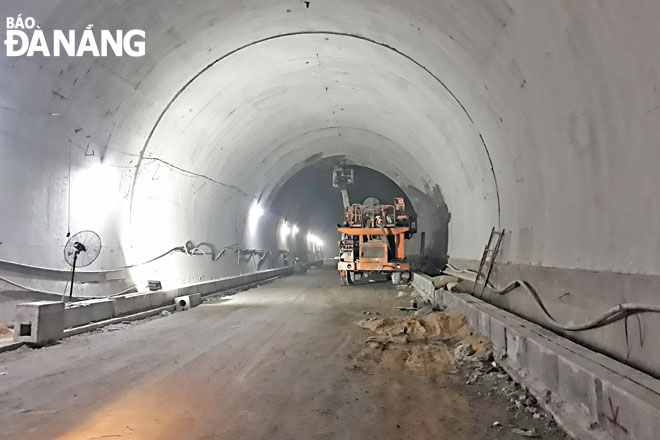Modern tunnelling technique used in Hai Van Tunnel 2 project
Drilling work at the Hai Van Tunnel 2, which runs through the namesake treacherous mountain, has been completed 6 months ahead of schedule, hereby ensuring its official opening to traffic next year.
 |
| Drilling work at the Hai Van Tunnel 2 has been completed 6 months ahead of schedule |
Starting work in February, 2017, the over 8,500 billion VND project involves the expansion of the over 6.2 km-long, 2-lane emergency tunnel, which lies parallel to the existing main tunnel, into a 4-lane one, and building a new 2.1 km-long stretch of road to Thua Thien-Hue Province’s Lang Co Town, and a 4.3 km-long roadway leading to Da Nang.
The Ho Chi Minh City-headquartered Deo Ca Investment JSC is in charge of deploying the project on the build-operate-transfer (BOT) basis.
According to the Vice Chairman of the Board of Directors of the Deo Ca Investment JSC cum Director of the Hai Van Tunnel Project Management Board, Mr Nguyen Tan Dong, investment and construction methods, used in the development of the Deo Ca Tunnel under its namesake pass linking Phu Yen and Khanh Hoa provinces on National Highway No1, have been successfully applied in the deployment of the Hai Van 2 Tunnel project.
The new tunnel is being created using the New Austrian Tunnelling Method (NATM), also known as the sequential excavation method, which is a popular method of modern tunnel design and construction. This modern tunnelling technique has been successfully applied in many developed countries across the world because it has more advantages than conventional methods.
There is no denying that the deployment of the new tunnel project is considered one of Viet Nam’s technological breakthroughs, and demonstrates its enhanced tunnelling techniques.
Engineer Nguyen Van Quang, a technical assistant from the Hai Van Tunnel Project Management Board, said, during the implementation of the first tunnel under the Hai Van Pass many years ago, work items such as design, construction and supervision were implemented by Japanese enterprises, whilst Vietnamese ones participated in this project as subcontractors.
However, for the development of the second tunnel, Vietnamese people have mastered tunnelling techniques, and only a handful of Japanese experts gave support in terms of design and supervision consultancy.
 |
| The building of a roadway connecting the Hai Van Tunnel 2 to Da Nang is progressing well |
Besides, the authorities of the Da Nang and neighbouring Thua Thien Hue Province have paid special heed to handling site clearance work in a prompt manner, which has facilitated the progress of the project to be kept on track.
The existing Hai Van Tunnel, the first one running under the namesake pass, officially opened to traffic on 5 June 2005. At a cost of over 127 million USD, this was at the time the longest road tunnel in South East Asia, and one of the 30 longest in the world.
However, overload was expected to occur in the existing tunnel by 2021 due to the growing number of vehicles running through it.
To deal with this problem, on 26 May 2015, the Prime Minister gave the go-ahead for the deployment of a project to open a new tunnel under the Hai Van Pass in order to better cope with the burgeoning traffic flow through the existing tunnel. So, the Hai Van Tunnel 2 project was given the green light to be constructed.
During the construction, the project’s developer has been working closely with the Hai Van Tunnel Management and Operation JSC (Hamadeco), and the relevant agencies of Thua Thien-Hue Province and Da Nang, in a bid to effectively deploy the project whilst still ensuring the normal operation of the existing tunnel.







